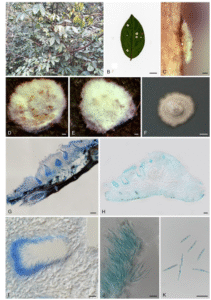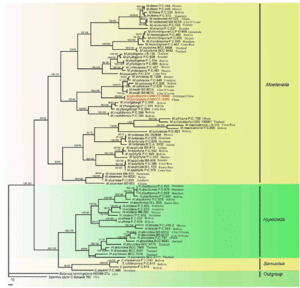Moelleriella gracilispora Jun Z. Qiu & Y.X. Chen, sp. nov.
Index Fungorum number: IF 556162; MycoBank number: MB 556162; Facesoffungi number: FoF 00010; Fig. 55
Etymology: Named after the slender spores.
Holotype: HMAS 247788.
Parasitic on whitefly nymph (Hemiptera), forming whitish to pale brown stromata on the underside of leaves. Sexual morph: Undetermined. Asexual morph: Coelomycetous. Stromata flattened pulvinate to discoid up to 3.2 mm diam and 0.6 mm high with a whitish tomentum, no reaction to 3% KOH, upper surface roughened, opaque, without hypothallus. Conidiomata pycnidial, yellow to orange, solitary or gregarious, completely embedded and on top part of stroma, numerous pycnidia per stroma, flask-shaped, multi-loculate, with locules, 166 (83–236) × 93 (53–136) μm, ostiolate. Ostioles subcylindrical, single, well-developed, centrally located. Wall of conidiomata 18–31 μm wide, composed of relatively thick-walled, pale brown to hyaline cells. Paraphyses 66 (36–103) × 0.6(0.4–0.8) μm, filiform, tapering at the apices, arising from the hymenium of the conidioma. Conidiophores reduced to conidiogenous cells. Conidiogenous cells 6–12 × 0.8–1.3 μm, hyaline, phialidic, cylindrical, broad at base, discrete, thick- and smooth-walled. Conidia fusoid, sometimes narrowly fusiform, unicellular, straight or slightly curved, 11.8(11–12) × 1.4(1–2) μm, l/w 8.4(7–10), accumulating in a slimy pale brownish mass above the conidioma.
Culture characteristics: Conidia germinating within 24 h on PDA. Colonies on PDA at 25 °C; compact, whitish, attaining ca. 1 cm diam after 2 wks. Optimal temperature 20–26 °C, with no growth below 5 °C or above 35 °C. Stromatic colonies pale yellow, forming moderately compact stromata. Conidial masses yellowish orange to orange, abundant, appearing on surface of stromatic colonies after ca. 2 wk. Material examined: CHINA, Fujian Province, Wuyishan City, Wu Yi Mountain, alt. 1000 m, on infected whitefly nymphs (Hemiptera), Junzhi Qiu, 30 July 2017, WYFC2017-03, WYFC2017-03 (HMAS 247788, holotype); HMAS 247,789, ex-type living cultures, CGMCC 3.18989, CGMCC 3.18990.
GenBank numbers: LSU: KC964202; TEF-1α: KC964191; RPB1: KC964179.
Notes: We were unable to find a teleomorph of this species in our survey of entomopathogenic fungal diversity throughout the year. Phylogenetic analysis based on LSU, RPB1 and TEF-1α sequence data showed that Moelleriella gracilispora is phylogenetically distinct from M. zhongdongii, M. mollii and M. ochracea (Fig. 56). M. gracilispora morphologically resembles M. libera, M. evansii and M. zhongdongii in having pulvinate stroma, a yellow mass of extruded spores and fusiform conidia. However, the conidia and paraphyses of M. gracilispora are somewhat narrower (11.2–12.3 × 1.3–1.6 μm and 0.6 μm respectively). In contrast, the anamorph of M. libera (= Aschersonia aleyrodis) produces conidia measuring 10–16 × 1.5–2 μm, with paraphyses 1–1.5 μm wide; M. evansii has conidia measuring 10–16 × 1.5–2 μm, and is without paraphyses; the anamorph of M. zhongdongii (= A. incrassata) has conidia measuring 10–18 × 1.5–2 μm, with paraphyses sometimes present. The Chinese specimens were most similar to Aschersonia andropogonis (= M. ochracea) in having pulvinate stroma, yellowish orange to orange spore masses and fusiform conidia. However, M. gracilispora differs from A. andropogonis in the absence of a hypothallus and size of conidia. M. gracilispora produces longer and narrower conidia measuring 11.2–12.3 × 1.3–1.6 μm in comparison with 8–14 × 1.5–2 μm in A. andropogonis.

Fig. 55 Moelleriella gracilispora (CGMCC3.18989, holotype). a Habitat. b Stroma on the underside of leaves. c Flank of stroma. d, e Frontage of stroma. f Colonies on PDA media. g, h Longitudinal section of stroma. i Section of pycnidium. j Conidiogenous cells. k Conidia. Scale bars: b = 1 cm, c–e = 0.2 mm, f = 0.5 cm, g, h = 100 µm, i = 20 µm, j, k = 10 µm

Fig. 56 Phylogenetic position of Moelleriella gracilispora (CGMCC3.18989, holotype) inferred from a combined dataset of LSU, RPB1 and TEF-1α sequences. Bootstrap support values for ML and MP ≥ 50% are given near nodes respectively. The tree is rooted with Balansia henningsiana (AEG96-27a) and Epichloe elymi (C. Schardl 760). The new species is indicated in red
